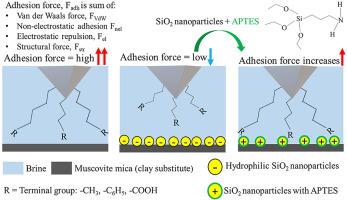Journal of Petroleum Science and Engineering Pub Date : 2021-05-04 , DOI: 10.1016/j.petrol.2021.108897 Dayo Afekare , Jayne Garno , Dandina Rao

|
Enhanced oil recovery (EOR) techniques have the potential to improve recovery in unconventional shale oil reservoirs which have prolific short-term success but elusive near-to-long term outlook. The use of silicon dioxide nanoparticles for enhancing shale oil recovery has recently gained significant attention in the oil industry. However, the technique remains novel partly due to inadequate fundamental understanding of oil release mechanisms. Herein, the oil recovery potential of untreated and treated silica nanoparticles is investigated using an atomic force microscope (AFM) by studying nanoscale interactions between different crude oil functional species and substrates of pure minerals found in a shale oil reservoir. Quartz and muscovite mica (clay substitute) were employed as substrates as these are the dominant rock minerals identified in the most productive zone of Tuscaloosa Marine Shale (TMS). Thiolates of undecane (CH3) and phenyl (C6H5) compounds were used to simulate alkane and aromatic fractions of TMS crude oil respectively, while undecanoic acid (COOH) thiol was used to represent carboxylic acid found in asphaltene and resin components. Following our in-house experimental protocol for liquid cell force spectroscopy, adhesion forces and surface energies between functionalized AFM probes and mineral substrates were characterized in untreated and amino-treated silica nanoparticle dispersions. Zeta potential of respective nanofluid solutions was measured and AFM adsorption data were supported with scanning electron microscope (SEM) micrographs of TMS rock samples. Results showed that aqueous dispersions of hydrophilic silicon dioxide nanoparticles promote wettability towards a less oil-wet state by significantly lowering the adhesion force and energy barrier to spontaneously detach oil molecules from clay and quartz mineral surfaces in shale reservoirs, shown at the nanoscale with AFM studies. However, the grafting of aminosilanes onto surfaces of silica nanoparticles generally increased adhesion forces and surface energies due to surface charge effect and hydrophobicity. Findings pertinent to nanoparticle silanization were consistent in molecular interactions on mica in nanofluids but not necessarily predictable with quartz surfaces, highlighting mineralogical effects. The irreversible adsorption of silica nanoparticles was also observed. Adhesion force and energy are resolved in various intermolecular forces such as electric double layer repulsion, non-electrostatic interaction and structural forces. The scientific significance and broad engineering implications of results were comprehensively discussed in the context of previously reported core-to-field scale observations of nanofluid EOR. This study pitches new light on the scientific understanding of silica-based nanofluid EOR by probing nanoscale wetting effects of silica nanoparticles with implications for shale oil recovery. The findings herein can help for better understanding of the design of nanofluid EOR reagents and the conditions that favor application of silica nanofluid EOR.
中文翻译:

使用二氧化硅纳米颗粒提高采收率:纳米级润湿性改变效应及其对页岩油采收的意义
增强油采收率(EOR)技术具有改善非常规页岩油藏采收率的潜力,这些非常规页岩油藏近期取得了丰硕的成果,但其远景和远景却难以捉摸。二氧化硅纳米颗粒用于提高页岩油采收率的用途最近在石油工业中引起了广泛的关注。但是,该技术仍然是新颖的,部分原因是对油的释放机理缺乏基本的了解。在此,通过研究页岩油藏中发现的不同原油功能物种与纯矿物基质之间的纳米级相互作用,使用原子力显微镜(AFM)研究了未处理和处理过的二氧化硅纳米颗粒的采油潜力。石英和白云母云母(粘土替代物)被用作基质,因为它们是在塔斯卡卢萨海洋页岩(TMS)的最高产区确定的主要岩石矿物。十一烷的硫醇盐(CH3)和苯基(C 6 H 5)化合物分别用于模拟TMS原油的烷烃和芳烃馏分,而十一烷酸(COOH)硫醇用于代表沥青质和树脂组分中发现的羧酸。遵循我们针对液体细胞力光谱的内部实验规程,在未经处理和经氨基处理的二氧化硅纳米粒子分散液中表征了功能化AFM探针与矿物基质之间的粘附力和表面能。分别测量了纳米流体溶液的Zeta电位,并用TMS岩石样品的扫描电子显微镜(SEM)显微照片支持了AFM吸附数据。结果表明,亲水性二氧化硅纳米颗粒的水分散体通过显着降低页岩储层中粘土和石英矿物表面自发分离油分子的粘附力和能垒,从而显着降低了粘附力和能垒,从而提高了向油湿态的润湿性。 。然而,由于表面电荷效应和疏水性,将氨基硅烷接枝到二氧化硅纳米颗粒的表面上通常增加了粘附力和表面能。与纳米硅烷化有关的发现在纳米流体中的云母上的分子相互作用中是一致的,但对于石英表面不一定是可预测的,从而突出了矿物学效应。还观察到二氧化硅纳米粒子的不可逆吸附。粘附力和能量可以通过各种分子间力来解决,例如双电层排斥力,非静电相互作用和结构力。在先前报道的纳米流体EOR的核心到现场规模观测的背景下,全面讨论了结果的科学意义和广泛的工程意义。这项研究通过探索二氧化硅纳米颗粒的纳米尺度润湿效应对页岩油回收的影响,为基于二氧化硅的纳米流体EOR的科学理解提供了新的思路。本文的发现可有助于更好地理解纳米流体EOR试剂的设计以及有利于应用二氧化硅纳米流体EOR的条件。在先前报道的纳米流体EOR的核心到现场规模观测的背景下,全面讨论了结果的科学意义和广泛的工程意义。这项研究通过探索二氧化硅纳米颗粒的纳米尺度润湿效应对页岩油回收的影响,为基于二氧化硅的纳米流体EOR的科学理解提供了新的思路。本文的发现可有助于更好地理解纳米流体EOR试剂的设计以及有利于应用二氧化硅纳米流体EOR的条件。在先前报道的纳米流体EOR的核心到现场规模观测的背景下,全面讨论了结果的科学意义和广泛的工程意义。这项研究通过探索二氧化硅纳米颗粒的纳米尺度润湿效应对页岩油回收的影响,为基于二氧化硅的纳米流体EOR的科学理解提供了新的思路。本文的发现可有助于更好地理解纳米流体EOR试剂的设计以及有利于应用二氧化硅纳米流体EOR的条件。这项研究通过探索二氧化硅纳米颗粒的纳米尺度润湿效应对页岩油回收的影响,为基于二氧化硅的纳米流体EOR的科学理解提供了新的思路。本文的发现可有助于更好地理解纳米流体EOR试剂的设计以及有利于应用二氧化硅纳米流体EOR的条件。这项研究通过探索二氧化硅纳米颗粒的纳米尺度润湿效应对页岩油回收的影响,为基于二氧化硅的纳米流体EOR的科学理解提供了新的思路。本文的发现可有助于更好地理解纳米流体EOR试剂的设计以及有利于应用二氧化硅纳米流体EOR的条件。











































 京公网安备 11010802027423号
京公网安备 11010802027423号